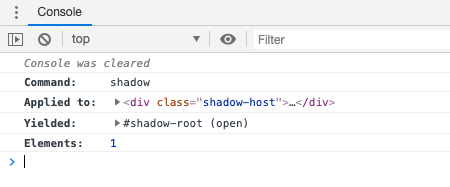shadow
Traverse into the shadow DOM of an element.
Syntax
.shadow(selector)
.shadow(selector, options)
Usage
Correct Usage
cy.get('.shadow-host').shadow()
Incorrect Usage
cy.shadow() // Errors, cannot be chained off 'cy'
cy.exec('npm start').shadow() // Errors, 'exec' does not yield DOM element
cy.get('.not-a-shadow-host').shadow() // Errors, subject must host a shadow root
Yields
-
.shadow()yields the new DOM element(s) it found.
Examples
Find and click on a button inside the shadow DOM
<div class="shadow-host">
#shadow-root
<button class="my-button">Click me</button>
</div>
// yields [#shadow-root (open)]
cy.get('.shadow-host').shadow().find('.my-button').click()
Rules
Requirements
-
.shadow()requires being chained off a command that yields a DOM element that is a shadow host (i.e. has a shadow root directly attached to it).
Assertions
-
.shadow()will automatically retry until the element(s) exist in the DOM -
.shadow()will automatically retry until the element(s) host(s) a shadow root. -
.shadow()will automatically retry until all chained assertions have passed
Timeouts
-
.shadow()can time out waiting for the element(s) to exist in the DOM . -
.shadow()can time out waiting for the element(s) to host a shadow root. -
.shadow()can time out waiting for assertions you've added to pass.
Command Log
Traverse into the shadow DOM of an element
cy.get('.shadow-host').shadow()
The commands above will display in the Command Log as:

When clicking on the shadow command within the command log, the console
outputs the following:

See also
cy.get()withincludeShadowDomoptioncy.find()withincludeShadowDomoptioncy.contains()withincludeShadowDomoptionincludeShadowDomconfig option